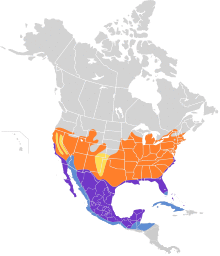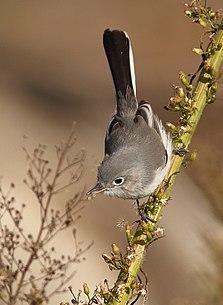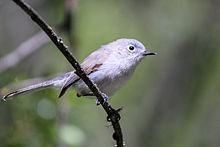| Blue-gray gnatcatcher | |
|---|---|
.jpg) | |
| Call recorded in Minnesota | |
| Scientific classification | |
| Kingdom: | Animalia |
| Phylum: | Chordata |
| Class: | Aves |
| Order: | Passeriformes |
| Family: | Polioptilidae |
| Genus: | Polioptila |
| Species: | P. caerulea |
| Binomial name | |
| Polioptila caerulea (Linnaeus, 1766) | |
 | |
| Synonyms | |
| Motacilla caerulea Linnaeus, 1766 | |

The blue-gray gnatcatcher or blue-grey gnatcatcher (Polioptila caerulea) is a very small songbird, 10–13 cm (3.9–5.1 in) in length, 6.3 in (16 cm) in wingspan,[2] and weighing only 5–7 g (0.18–0.25 oz).[3][4] Adult males are blue-gray on the upperparts with white underparts, have a slender dark bill, and a long black tail edged in white. Females are less blue, while juveniles are greenish-gray. Both sexes have a white eye ring.
The blue-gray gnatcatcher's breeding habitat includes open deciduous woods and shrublands in southern Ontario, the eastern and southwestern United States, and Mexico. Though gnatcatcher species are common and increasing in number while expanding to the northeast,[5] it is the only one to breed in Eastern North America. Both parents build a cone-like nest on a horizontal tree branch, and share feeding the young. The incubation period is 13 days for both sexes, and two broods may be raised in a season.

These birds migrate to the southern United States, Mexico, northern Central America-(Belize, Guatemala, and Honduras), Cuba, Bahamas, Turks and Caicos Islands, and the Cayman Islands.
They forage actively in trees or shrubs, mainly eating insects, insect eggs and spiders. They may hover over foliage while snatching prey (gleaning), or fly to catch insects in flight (hawking).
The tail is often held upright while defending territory or searching for food.
Sounds
The songs (and calls) are often heard on breeding grounds, (usually away from nest) and occasionally heard other times of the year. Calls: "zkreee, zkreee, zkreee", Songs: "szpree zpree spreeeeey spree spre sprzrreeeee"
Breeding
Both parents build a cone-like nest on a horizontal tree branch, and share feeding the young. The incubation period is 13 days for both sexes, and two broods may be raised in a season.
References
- ^ BirdLife International (2015). "Polioptila caerulea". IUCN Red List of Threatened Species. 2015. Retrieved 1 June 2016.
- ^ "Blue-gray Gnatcatcher Identification, All About Birds, Cornell Lab of Ornithology". www.allaboutbirds.org. Retrieved 2020-09-28.
- ^ "Blue-gray Gnatcatcher". All About Birds. Cornell Lab of Ornithology.
- ^ "Blue-gray Gnatcatcher Polioptila caerulea". eNature.com. Archived from the original on 2012-04-28.
- ^ Greenberg, Russell (2001). Birds of North America. Sean Moore.
External links
- Blue-gray gnatcatcher - Polioptila caerula - USGS Patuxent Bird Identification InfoCenter
- Blue-grey gnatcatcher stamps from Turks and Caicos at bird-stamps.org
- "Blue-grey gnatcatcher media". Internet Bird Collection.
- Blue-gray gnatcatcher photo gallery at VIREO (Drexel University)
- Blue-gray gnatcatcher Bird Sound at Florida Museum of Natural History
- BirdLife species factsheet for Polioptila caerulea
- "Polioptila caerulea". Avibase.

- Interactive range map of Polioptila caerulea at IUCN Red List maps
- Audio recordings of Blue-gray gnatcatcher on Xeno-canto.

.jpg)
.jpg)